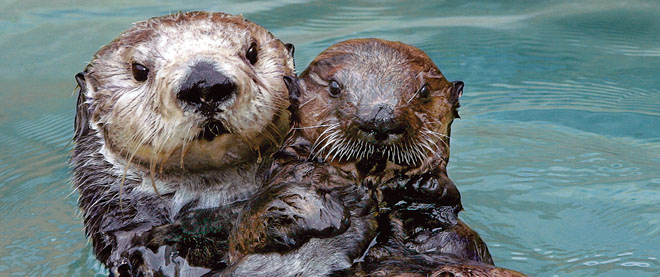Toola, the first captive sea otter to raise stranded pups
The unique story of a marine mammal foster mom raised awareness—and donations
Share

Toola the sea otter arrived at California’s Monterey Bay Aquarium in July 2001, after volunteer conservationists found her stranded, pregnant and gravely ill on the sands of nearby Pismo Beach. Toola was infected with a parasite common to southern sea otters, an endangered species off the central California coast. The parasite had reached her brain, inflicting her with a neurological disorder that gave her regular grand mal seizures, which rack the entire body and leave the stricken animal dazed and confused. About two months later, experts at the aquarium concluded that the pregnant Toola, estimated to be six or seven years old, could only live with twice-daily doses of phenobarbital, an anti-convulsant drug. She would spend the rest of her life in captivity.
One morning, workers at the aquarium found Toola swimming in her tank, clutching the body of a dead pup. She had delivered it stillborn overnight. Ironically, the incident sealed Toola’s fate: animal care director Karl Mayer and his colleagues decided to replace the dead pup with a recently rescued two-week-old male in the hopes that Toola would adopt it as her own. “Because Toola had given birth to a full-term pup, she was essentially primed for motherhood,” says Mayer. “We were thrust into a situation which we conceptualized, but were never in a position to physically experiment with.”
Toola immediately took to the pup, feeding him milk and eventually teaching him to break open shells and forage for food. It was an unprecedented leap into surrogate motherhood for a captive sea otter that inspired the Monterey Bay Aquarium to create the world’s first and only rescue program that uses surrogate mothers to raise stranded otter pups for release in the wild.
Before Toola, the aquarium’s Sea Otter Research and Conservation (SORAC) program rehabilitated stranded otters through human rearing. But Mayer says that method presented consistent problems. Acclimatized to humans, released sea otters were known to climb on scuba divers and kayakers, he says. They were also less adept at survival skills like breaking open clamshells with their teeth, avoiding danger and diving to the ocean floor to find food. According to a 2007 study published in Biological Conservation, surrogate-reared pups foraged for food better than human-reared otters, and stayed away from humans.
Now, thanks to Toola, SORAC uses surrogates whenever possible. Since none of the mothers are “reproductively primed” to lactate and care for infant otters, orphaned pups aren’t introduced to their mothers until they’re old enough to eat solid food. Despite this, Mayer says the surrogate mothers accept new pups 85 per cent of the time. Toola, he adds, never rejected a new pup. Even if she showed reluctance at first, her maternal instincts always kicked in. “I don’t think anyone really knows what exactly switches that on,” says Tim Tinker, a wildlife biologist with the U.S. Geological Survey, about the phenomenon. “It might be something that [regularly] occurs in the wild, and we just really haven’t been that aware of it because it’s hard to see.”
Three other female adults—Joy, Mae and Rosa—now raise orphaned pups, too. Together with Toola, they have reared 40 baby otters, 37 of which were successfully released to the wild, says Mayer. Some of them are now making babies of their own, he adds. And it all started with Toola, who raised 13 pups during her time at the aquarium.
When she wasn’t rearing pups, Toola was kept in the aquarium’s public sea otter exhibit. One day, a state legislator named Dave Jones visited the aquarium with his family. His son, who was moved by Toola’s story, asked him if the government could do anything to help the sea otters. In 2006, California passed a bill that allows people to submit part of their yearly tax rebates to a sea otter research and conservation fund. So far, it has raised more than US$1 million.
“Toola had a really big impact in terms of making the millions and millions of visitors to the Monterey Bay Aquarium aware of sea otters and the threats to sea otters and the importance of marine conservation,” says Tinker, describing how pollution from urban activity and agriculture has reduced the number of southern sea otters off California to just 3,000.
Toola died on March 3 at the age of 16 or 17. “She has really captured people’s imaginations,” says aquarium spokesperson Ken Peterson. “She was a stalwart,” says Mayer. “At this point, there’s not an animal that’s waiting in the wings to replace her.”
Toola’s legacy is secure. Her first adopted pup, whom she embraced with compassion after the stillbirth, was released in 2002. Monitoring shows that he’s alive and has fathered children as the alpha male of an otter pack.